File Formats
We will work with a range of file types in class. There are rationales for as well as benefits and drawbacks to each format. Below is an introduction to various types you may encounter in the course of this class.- Raster
- is a image format that is based on a grid with a set number of squares, like a chess or checker board. The more squares the grid has the more detailed the image can be. Each square of the grid may be a different color. Digital photos and many graphics with finer detail are in raster form. BTW, the cells of the raster (what I referred to as squares above) don't have to be squares. For example, they can be rectangles, but we will only be working with squares in this class.
The individual cells (squares) of raster can each be a different color. These are the smallest elements in a raster and they are indivisible. These elements are referred to as pixels. The word pixel is a portmanteau for picture element.
However, because their pixel number is fixed, raster images can become distorted or blurry when resized to fill a bigger or smaller space. That’s why vector images are more commonly used for illustrations and logos. An important note about raster images. If one were to scale up a design made using a raster it is highly likely that it would get distorted and look pixelated. As a general rule, never scale up a raster image. Scaling down is often ok, but scaling up almost always results in poorer quality images.
Source (https://www.adobe.com/creativecloud/file-types/image/raster.html)
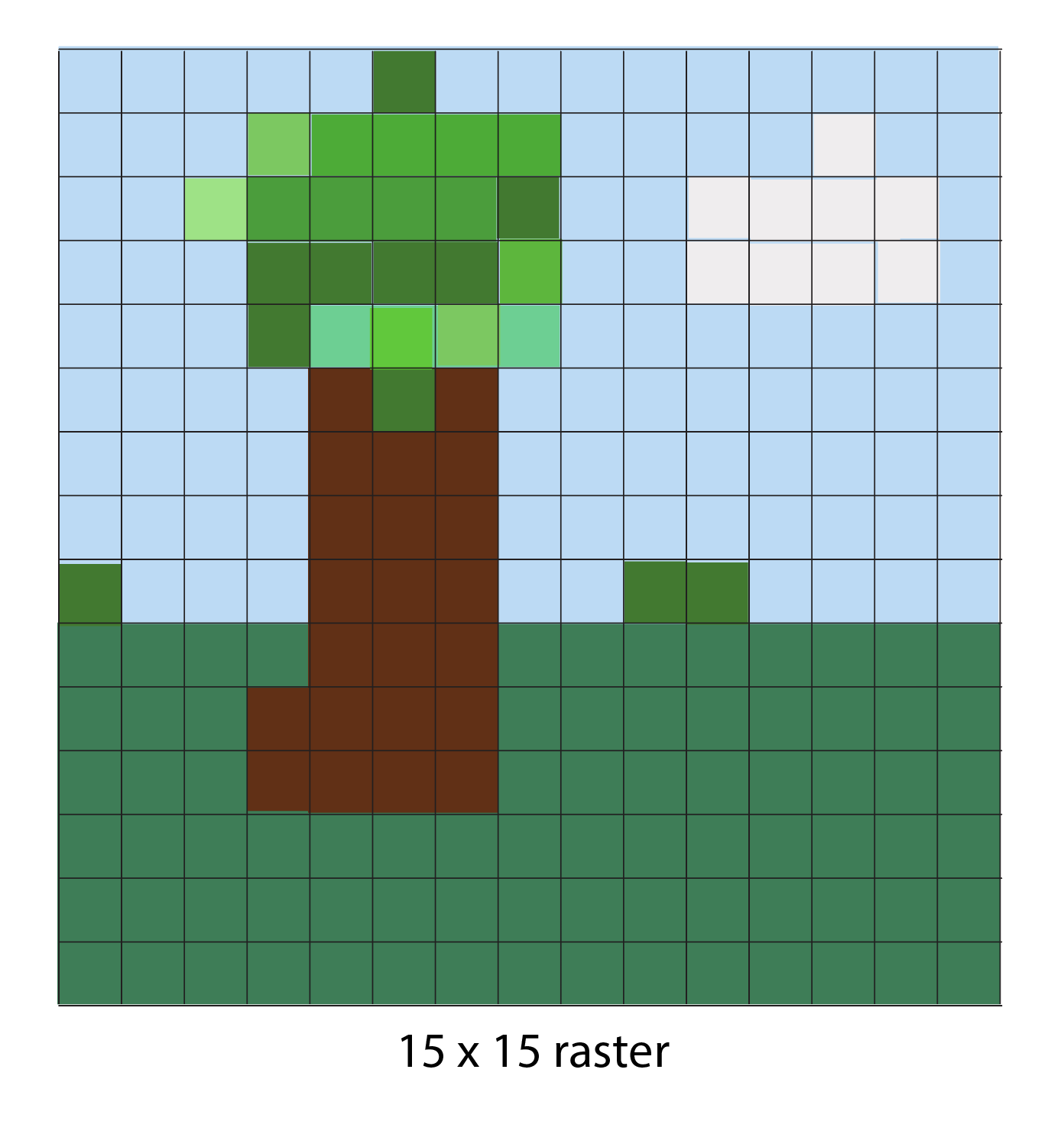
Below are images to demonstrate varying sizes of raster grids.
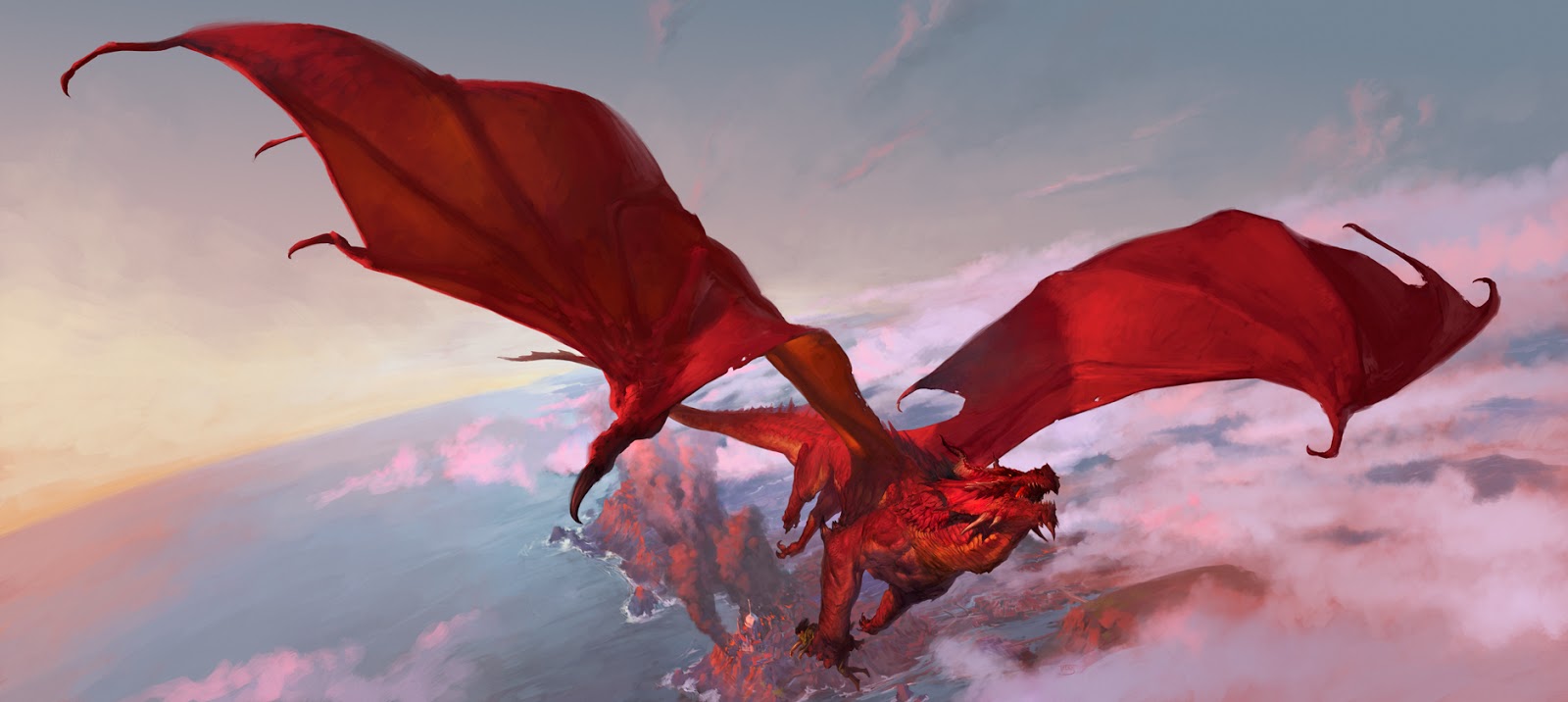
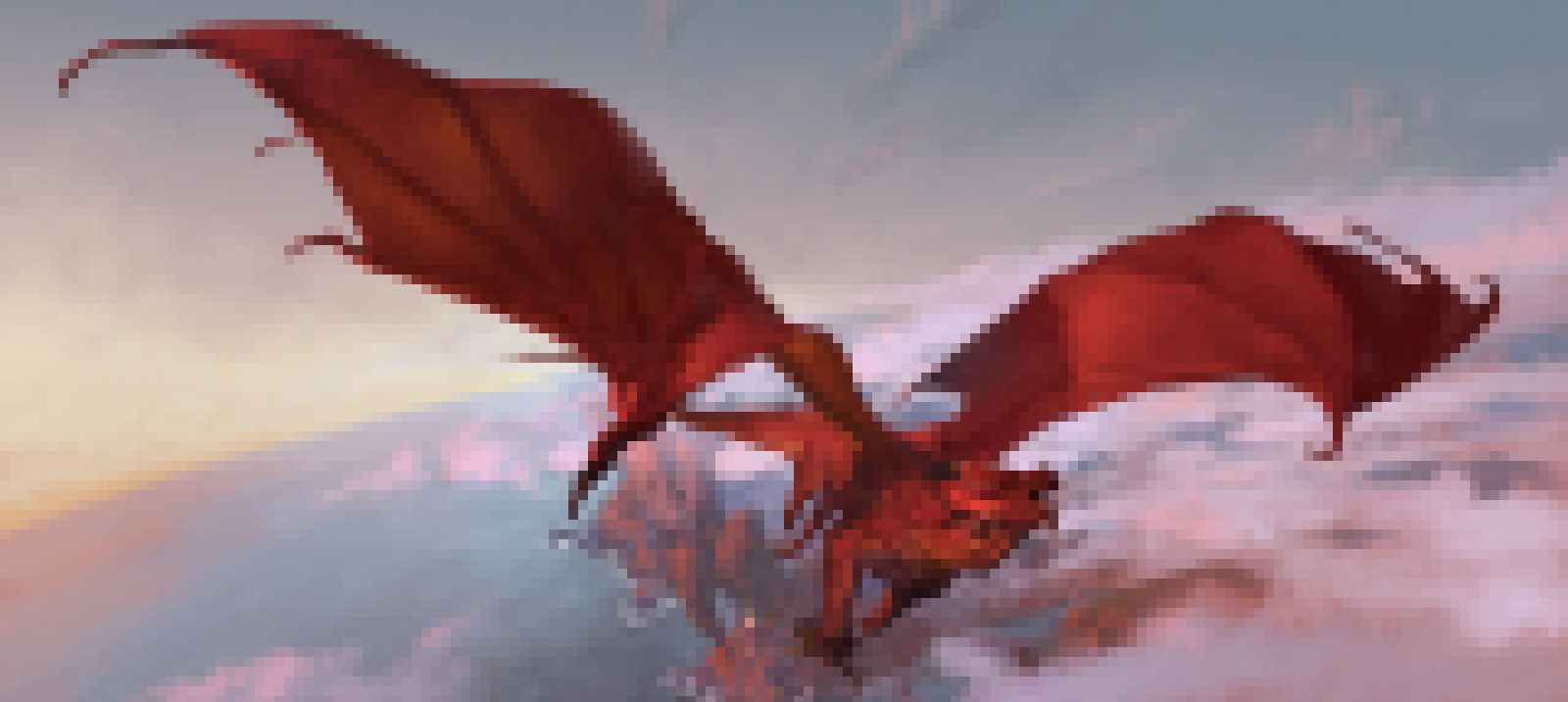

As you can see, the more pixels, the more likely you will have a highly detailed image. Original image copyright © Tyler Jacobson and Wizards of the Coast.
- Vector
- Vector images don’t use pixels. They’re created with mathematical equations, lines, and curves — using points fixed on a grid — which means images can be made infinitely larger (or smaller) without losing resolution. Basically, vectors don’t lose quality when resized.
The vector format is handy when you need high-quality graphics that can easily resize to different scales. Since they’re created using mathematical formulas, vector files won’t become fuzzy or distorted — no matter how large or small you make them.
Digital illustrations and company logos are frequently made in vector form because they often need to be sized up or down for a variety of promotional materials. For example, a logo would need to be a different size on a business card, product packaging, t-shirt or billboard. A logo saved in vector format won’t lose its resolution or look distorted when scaled up or down. If one were to scale up a logo made using a raster it is highly likely that it would get distorted and look pixelated.
Two common formats for vector images are SVG and AI (Adobe Illustrator).
Source (https://www.adobe.com/creativecloud/file-types/image/vector.html)
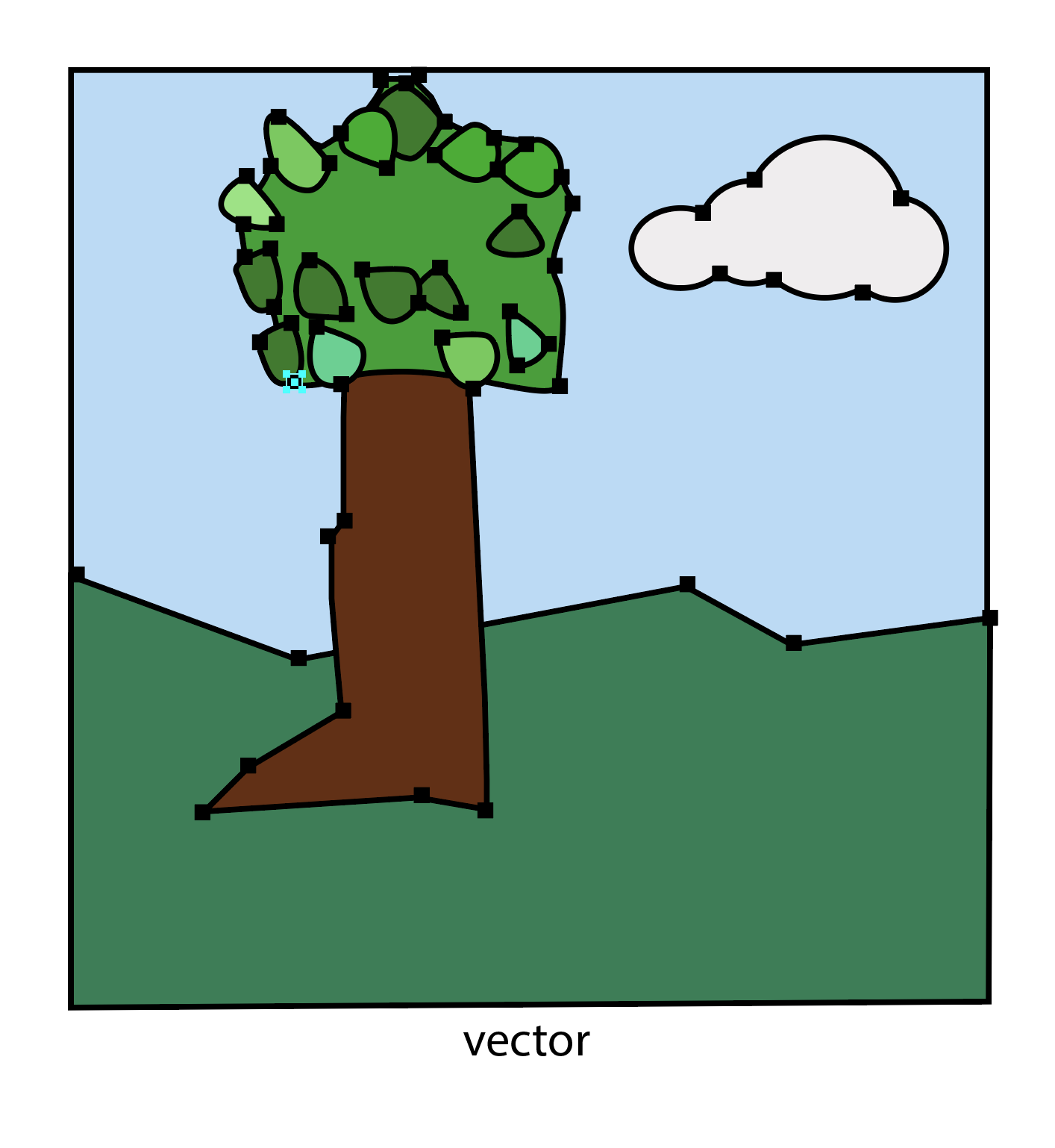

- CODEC
- is a device or program that encodes or decodes data or a signal. In the case of the following terms, it is a piece of code that compresses or decompresses an image file often to make the file size smaller while trying to preserve the visual quality of the image as best it can. CODEC stands for COmpression DECompression algorithm.
Some examples of CODECs are:
- JPG
- GIF
- PNG
- HEIC
- TIFF
- HEIC
- HEIC stands for High Efficiency Image Container. The format is an updated variant of the High Efficiency Image Format
(HEIF), traditionally used by Apple across its mobile devices.
Apple uses HEIC for HEIF images. HEIF essentially saves images in higher quality than JPEG while also using less space thanks to advanced compressive technology. This space-saving file format uses High Efficiency Video Coding (HEVC) to compress and store images on device drives — taking up half the space of other image file formats, like JPEGs.
Despite the fact that this format creates images with approximately half the file size, Google nor Microsoft have not adopted it as of 2023.
Each HEIC file uses the .heic or .heics extension, depending on the number of images inside. The file also contains the relevant metadata describing each image’s size, resolution, location, and more.
Source (https://www.adobe.com/creativecloud/file-types/image/raster/heic-file.html)Printing may be problematic with HEIC images. The reason why HEIC images might not print accurately is that they use a different color profile than what many printers expect. HEIC images use the Display P3 color space, which has a wider gamut (i.e., range of colors) than sRGB, which is a widely used color profile that is designed to be compatible with most printers, monitors, and web browsers. Most photo printers print in sRGB. This means that when you print a HEIC photo, the colors might appear oversaturated or washed out, depending on the printer's capabilities.
Source (https://www.nationsphotolab.com/blogs/blog/convert-heic-photos-before-printing#Why-HEIC-isn't-the-best-if-you're-printing-photos)
- JPG
- Also known as JPEG, this refers to a CODEC for images files that uses a file compression method originally developed by the Joint Pictures Experts Group in the late 1980s and published in 1992. JPEG compression allows for adjustment between image quality and file size with lower file size resulting in a lower visual quality while a higher quality image results in larger file size. This CODEC is most often used with digital photography and it is the most widely used image compression method in the world. JPEG is a lossy form of file compression. This format was developed for displaying images on screens and is commonly seen on the World Wide Web. This format is not a recommended format for printing.
Look closely at the following two images. Both are JPG files. The first has been compressed to a size of 19K. The second has been compressed only to 283K. Can you see the difference in image quality?
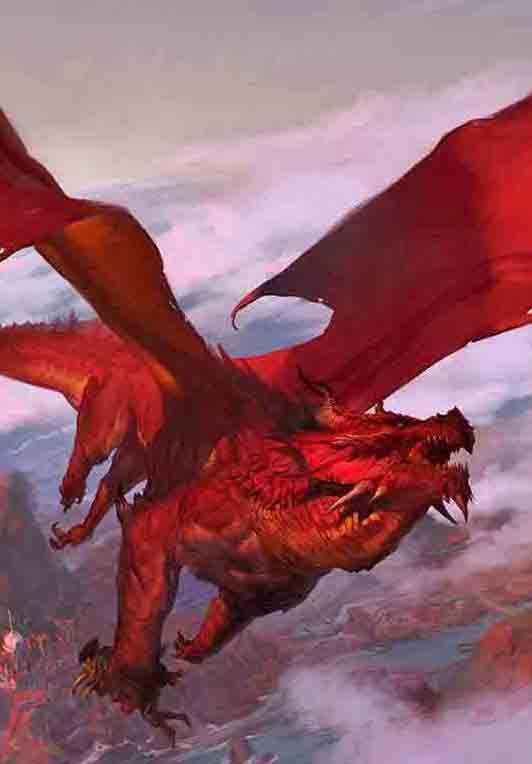

The distortions and marks visible in the first image are called artifacts. This is not desirable and indicates that the image has been compressed too far and thus results in a noticeable loss of image quality. See lossy compression below.
JPEG 2000
JPEG 2000 is a newer version of JPEG, but it is quite different. Learn more here. JPEG vs. JPEG 2000 at Adobe.com
- GIF
- is a bitmap image format that was developed by a team at the online services provider CompuServe in 1987. It is best for graphic images with a limited color range (perhaps five or fewer colors) such as logos or other graphic images. It also supports transparency and animation. GIF images are compressed using the Lempel–Ziv–Welch (LZW) lossless data compression technique to reduce the file size without degrading the visual quality. This format was developed for displaying images on screens and is commonly seen on the World Wide Web. This format is not a recommended format for printing.
- PNG
- Portable Network Graphics is a raster image format that employs lossless data compression. PNG was created to improve upon and replace GIF (Graphics Interchange Format) as an image-file format not requiring a patent license. PNG supports palette-based, grayscale, or RGB images. PNG does not support CMYK color spaces.
Source (https://surferhelp.goldensoftware.com/subsys/subsys_portable_network_graphic_file_description.htm)PNGs offer a much broader and brighter color palette.
PNGs were developed for use on screens and are common on the World Wide Web. This format supports transparency. PNG is not a recommended format for printing.
Source (https://www.adobe.com/creativecloud/file-types/image/raster/png-file.html)
- Portable Document Format. This format was designed by Adobe to look the same on screen and in print while striving for the smallest possible file size. PDF is widely accepted as the standard print job format. It is considered by many to be the most interchangeable and best format for sharing files with colleagues and business partners digitally.
- TIFF
- This file format was designed for printing and desktop publishing by the Aldus corporation in the 1986. It has been updated numerous times since then. The format is for storing raster graphics images, often used by graphic artists, the publishing industry, and photographers. TIFF is widely supported by scanning, faxing, word processing, optical character recognition, image manipulation, desktop publishing, and page-layout applications.
This is a great format for scanning or printing, but it is not a good web format.
- PSD
- is the native file format for Adobe Photoshop files. PSD stands for Photoshop Document. This is an acceptable format for printing. Adobe Photoshop is a raster based image editing program and is perhaps the most well known image editing software for use by professionals. The first publicly available version of Adobe Photoshop came out in 1990. When saving a Photoshop document, one must use the PSD format in order to retain all editing possibilities. For example, if one were to save a Photoshop document as a JPG file without also keeping and saving the PSD form, one would lose all layers and editing possibilities that come with that.
- AI
- is the native file format for Adobe Illustrator. Neither this file format nor its name are related to artificial intelligence. Adobe Illustrator is a vector based graphic arts program. This is an acceptable format for printing. When saving an Illustrator document, one must use the AI format in order to retain all editing possibilities. For example, if one were to save an Illustrator document as a PNG file without also keeping and saving the AI form, one would lose all layers and editing possibilities that come with that.
- Lossy (compression)
- also known as irreversible compression is the class of data compression methods that uses inexact approximations and partial data discarding to represent the content. The resulting image is smaller, but it is also changed forever, hence the term irreversible. The resulting image is of lower quality and repeatedly saving out a file using lossy compression continues to degrade the resulting image files. JPEG, MPEG, MP3, and HVEC are examples of lossy compression.
The opposite of lossy compression is lossless. PNG, ZIP, and WAV are examples of lossless conmpression.
- RAW files
- A RAW file is the uncompressed and unprocessed image data captured by a digital camera or scanner’s sensors. Shooting in RAW captures a high level of image detail, with large file sizes and lossless quality. The direct image data means you start with a high-quality image that can be edited, converted, and compressed in a non-destructive manner.
RAW files are a type of raster file format, but not actually images themselves. This means you need to import them into relevant software before you can edit or export them as a different raster image file, like a JPEG. Many photographers who shoot in RAW manipulate the original data in software like Photoshop before compressing the RAW file into a different format for print or online.
Source (https://www.adobe.com/creativecloud/file-types/image/raw.html)
- MPEG
- is the acronym for the Moving Pictures Experts Group which was started in 1988. You likely were not aware of them even though you may have heard the term MPEG before. This is because when we say MPEG we generally are refering to the name for the CODEC developed by the group. This CODEC is used for the compression of audio and video. Several versions have been created over the years. Currently, version four (MPEG-4) is the one that is used for encoding video for Blu-Ray discs/players. (Version three was for DVDs).
File formats that are best for Printing
- TIFF
- PSD
- AI
Files should be at 300 ppi (pixels per inch) for best results when printing. Also note that when a file is saved in Photoshop the ppi is changed to 72.